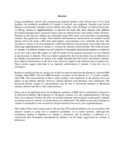| dc.description.abstract | Using non-diabetic control and streptozotocin-induced diabetic male Wistar rats of 4-6 week duration, the metabolic availability of vitamin A (retinol) was examined. Animals were fed ad libitum a nutritionally complete semi-synthetic diet either with (36 RE/g) or without (basal diet, 3.6 RE/g) vitamin A supplementation; or pair-fed the basal diet. Rats induced with diabetes developed hyperglycemia, increased urinary glucose and increased water intake within 48 hours. Despite the fact that the diabetic rats consumed nearly 50% more food than their corresponding controls, they gained less weight. These animals had decreased concentrations of vitamin A in the plasma and in the retina, while their total hepatic concentrations were markedly elevated. The circulatory vitamin A levels remained low while their hepatic concentrations were further elevated following supplementation of vitamin A, 10 times the amount in the basal diet. This reduced status of vitamin A in diabetic animals was not caused by its impaired intestinal absorption as evident by an in vitro study where the uptake of ( H) retinol by the jejunum and ileum was not affected in the presence of diabetes. This was further supported by the fact that there was no difference in the hepatic concentrations of vitamin A in weight matched pair-fed control and diabetic animals. Free retinol concentrations in the liver were, however, higher in the diabetic than in control rats. These results suggest that there is an impaired mobilization of vitamin A from the liver to circulation.
Retinol is mobilized from its storage site in the liver and secreted into the plasma as a retinol-RBP complex (holo-RBP). The holo-RBP normally circulates in the plasma as a 1:1 molar complex with TTR. The concentrations of these carrier proteins were depressed in the plasma, liver and kidney of the diabetic animals: however, plasma albumin concentrations were unaffected. The decreased plasma vitamin A concentrations may be due to decreased synthesis or decreased stability (shorter half-life) of the carrier proteins.
Since zinc is an important factor for the hepatic synthesis of RBP and its metabolism is known to be affected in diabetes, the responses of circulatory vitamin A to zinc supplementation (120 ug/g diet) was examined. Further, the effect of insulin treatment (subcutaneous insulin pellet implant) on plasma and liver vitamin A concentrations was determined. The diabetes associated changes in vitamin A metabolism were reversed by insulin treatment but not by zinc supplementation.
The results of this study clearly point to the fact that STZ-induced diabetic rats are associated with reduced vitamin A status due to impaired availability of its carrier proteins. Although the mechanism leading to blindness in vitamin A deficiency and in diabetes is different, it is conceivable that retinopathy precipitated by diabetes can be further aggravated by vitamin A deficiency. | en_US |

